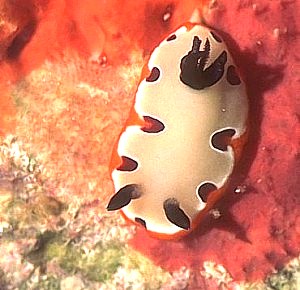
Chromodoris fidelis
(Kelaart, 1858)
Order: NUDIBRANCHIA
Suborder: DORIDINA
Family: Chromodorididae
DISTRIBUTION
Tropical Indo-West Pacific.
PHOTO
UPPER: Heron Is, Qld, PHOTO: Julie Booth.
LOWER LEFT: Suakin, Sudan, Red Sea, April 1980. PHOTO: C. Todd
LOWER RIGHT: Koumac, New Caledonia, October 1993. PHOTO: Bill Rudman.
The mantle is creamy white with a broad orange band around the mantle edge and a thin wine red line between the white and the orange. On the inner edge of the orange band there are usually a series of tongue-like patches running into the white region. In some cases they are almost all wine red while in others there is only a slight thickening of the red band. Grows to 20-25mm long. Three common variations are illustrated here and all seem present throughout the Indo-West Pacific. Equally characteristic are the black rhinophores and gills and the white foot. In northern New South Wales there is, what I consider to be a unique colour form of this species.
Reference:
• Rudman, W.B. (1985) The Chromodorididae (Opisthobranchia: Mollusca) of the Indo-West Pacific: Chromodoris aureomarginata, C. verrieri and C. fidelis colour groups. Zoological Journal of the Linnean Society, 83: 241-299.
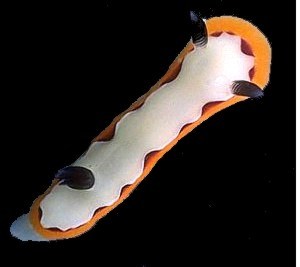
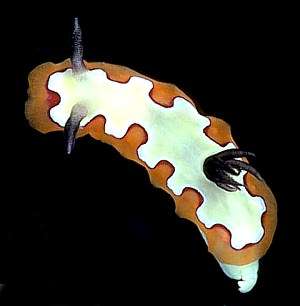
Rudman, W.B., 1999 (June 1) Chromodoris fidelis (Kelaart, 1858). [In] Sea Slug Forum. Australian Museum, Sydney. Available from http://www.seaslugforum.net/find/chrofide
Related messages
Chromodoris fidelis from Sri Lanka
December 10, 2007
From: Anouk Houben
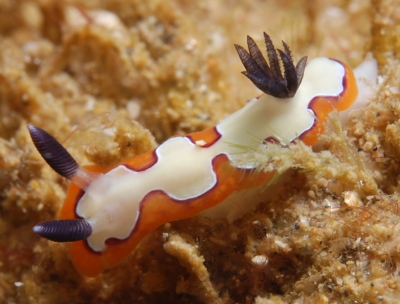
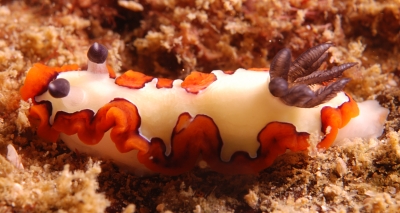
Hi Bill,
These are two pictures of Chromodoris fidelis found in Sri Lanka. They differ a bit in colour and the second one seems to have a lot more ruffled edge. They are not commonly sighted here.
Locality: Second reef, Negombo, 15 m, Western Province, Sri Lanka, Indian ocean, 22 April 2007 and 05 December 2007, Silty reef. Length: 2.5 cm. Photographer: Anouk Houben.
Cheers,
Anouk
nashiman@lankacom.net
Houben, A., 2007 (Dec 10) Chromodoris fidelis from Sri Lanka. [Message in] Sea Slug Forum. Australian Museum, Sydney. Available from http://www.seaslugforum.net/find/21287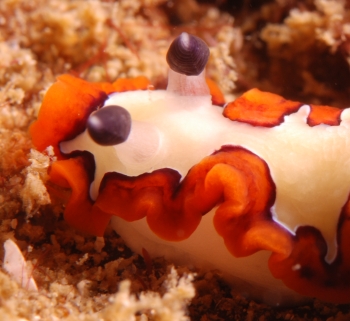
Dear Anouk,
It's interesting you should mention that C. fidelis is not so common in Sri Lanka as that is where the species was first found. It was named by Kelaart (1858) from specimens he collected at Trincomalee while stationed there as military surgeon to the British colonial troops.
AS you say, the animal in your lower photo looks to have a more ruffled mantle edge than usual. Overall it seems to be a bit bloated - as though the salinity was very low and it has taken in excess water - but that is just a guess.
Best wishes,
Bill Rudman
Chromodoris fidelis from Thailand
March 24, 2007
From: Paul Osmond
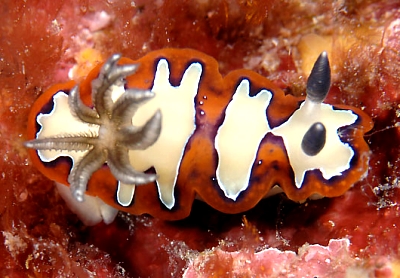
Hi Bill,
I believe this is a slightly different pattern for a Chromodoris fidelis where some of the mantle colors have actually joined and separated the mid body white areas. Is this correct?
Images were taken on the reef surrounding Racha Yai off of Phuket, Thailand.
Locality: Racha Yai Island, 25m, Phuket, Thailand, 13 March 2006, Fringing Reef Wall. Length: 20mm. Photographer: Paul T. Osmond.
Yours,
Paul
www.deepseaimages.com
marriard@deepseaimages.com
Osmond, P.T., 2007 (Mar 24) Chromodoris fidelis from Thailand. [Message in] Sea Slug Forum. Australian Museum, Sydney. Available from http://www.seaslugforum.net/find/19700
Dear Paul,
Yes I would consider this to be part of the colour variation of C. fidelis. In fact there is a 'form' in eastern Australia in which the red 'tongues' on each side have broken off to form red spots. My hypothesis is that this is a special case of mimicry to match the other red-spotted chromodorids found in south eastern Australia.
I have added a couple of close-ups from your photos which show another interesting feature. Most of you will be aware of the mantle glands chromodorids have around the edge of their mantle. They contain defensive chemicals from the sponges they feed on. In the photo alongside of the head of the animal you can see these glands as little whitish spheres around the mantle edge. Some species also have these glands in their gills as well, and as you can see here, C. fidelis is one species that does.
Best wishes,
Bill Rudman
A colour variant of Chromodoris fidelis ?
August 3, 2006
From: Takao Urasawa
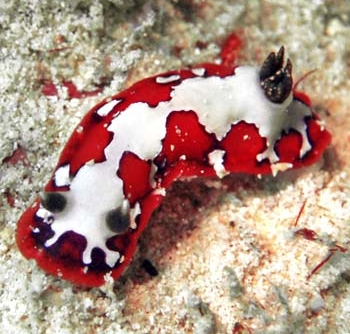
Dear Dr.Bill,
I think this animal is Chromodoris fidelis but we have never see this color pattern before.
Locality: Wreck Ship , 9m, Saipan, Northern Mariana Islands, Pacific Ocean, 12 July 2006, On the sands. Length: 10mm. Photographer: Takao Urasawa.
Would you give me your advice, please ?
Ura
dswith@isletwind.com
Takao Urasawa, 2006 (Aug 3) A colour variant of Chromodoris fidelis ?. [Message in] Sea Slug Forum. Australian Museum, Sydney. Available from http://www.seaslugforum.net/find/17309Dear Ura,
Chromodoris fidelis seems to have one of the most variable colour patterns. There are a few early messages on the Forum of animals from Papua New Guinea which are similar to your one [#2880, #2867, #5362], but all the colour patterns appear to merge into each another. Perhaps DNA studies will show there are a number of very similarly coloured species, but I haven't been able to find any anatomical differences.
Best wishes,
Bill Rudman
Chromodoris fidelis from the northern Marianas Ids
November 12, 2005
From: Takao Urasawa
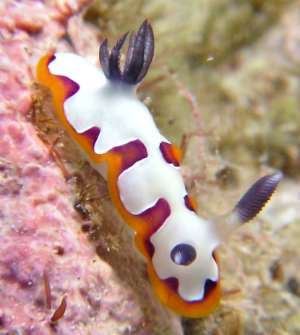
Dear Dr Rudman
I found Chromodoris fidelis in July this year.
Locality: Lau Lau beach Saipan, Northern Mariana Islands. Depth: 10 m. Length: 10 mm. July 2005. Photographer: Takao Urasawa
Takao Urasawa
dswith@isletwind.com
Takao Urasawa, 2005 (Nov 12) Chromodoris fidelis from the northern Marianas Ids. [Message in] Sea Slug Forum. Australian Museum, Sydney. Available from http://www.seaslugforum.net/find/15200Thanks Takao,
Bill Rudman
Chromodoris fidelis from Indonesia
September 23, 2005
From: Bob Widman
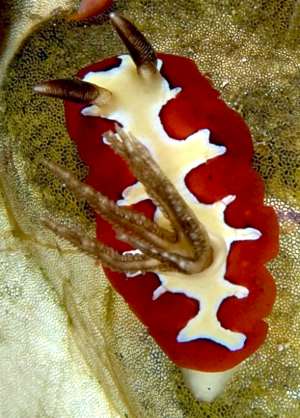
I found this nudibranch on a night dive. One of the dive masters said it was a 'Chromodoris reliable', but I can't seem to find anything that looks like this in a book or on the web. Can you identify it?
Locality: Wakatobi, Indonesia. Depth: 50 ft. Length: 1/4 inch.10 September 2005. Photographer: Bob Widman
Thanks,
Bob
bob@seashots.com
Widman, R., 2005 (Sep 23) Chromodoris fidelis from Indonesia. [Message in] Sea Slug Forum. Australian Museum, Sydney. Available from http://www.seaslugforum.net/find/14824Dear Bob,
This is a nice example of one of the colour forms of Chromodoris fidelis.
In Neville Coleman's 1001 Nudibranchs he made up 'common names' by trying to translate the scientific name into English so Chromodoris fidelis became "Reliable Chromodoris". This is as good an example as any of the silly practice of making up common names. Is this Chromodoris any more faithful or reliable than any other? .. and has this name any meaning for the majority of the world's population that don't speak English? Although most authors give a explanation these days when they make up a new scientific name, this was not the case a 100 years ago. However Kelaart, who named this species fidelis, usually gave obvious clues to why he gave species particular names. For example in the same paper he described Doris fidelis he writes 'This leopard-spotted Doris" in his description of Doris leoparda; ".. large marbled Doris..." for Doris marmorata; "This .... Doris resembles a piece of bone" from Doris osseosa, so his reasons are usually clear.
However for Doris fidelis I can find no clues. He says it " ... looks .. like a large bean. ....... It is very tenacious of life." Neither attributes seem to lead to 'fidelis' which means 'faithful' or 'reliable', but I must admit my Latin knowledge is very slight. I seem to have gone on at some length here. Suffice to say that if everyone had been 'faithful' to the scientific name then you wouldn't have needed to do a fruitless search for 'Chromodoris faithful'.
Best wishes,
Bill Rudman
Chromodoris fidelis from Burma
July 6, 2005
From: Sergey Parinov
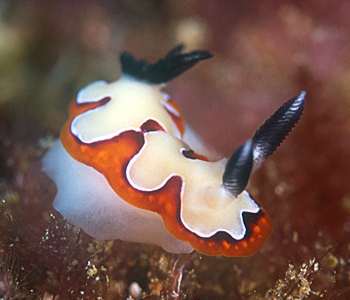
Dear Bill,
Here is a photo of Chromodoris fidelis from Mergui Archipelago, Burma. I have sent a photo of a group from another location separately [message #14203 ].
Locality: South Mergui, Myanmar [Burma]. Indian Ocean, Andaman Sea.
Depth: 3 m. Length: 1.5 cm. February 2004. small rock close to the shore
Photographer: Sergey Parinov
Sergey Parinov
www.sergeyphoto.com/underwater/nudibranchs.html
webmaster@sergeyphoto.com
Sergey Parinov, 2005 (Jul 6) Chromodoris fidelis from Burma. [Message in] Sea Slug Forum. Australian Museum, Sydney. Available from http://www.seaslugforum.net/find/14202Thanks Sergey,
The mantle glands are particularly noticeable in this photo
Best wishes,
Bill Rudman
Feeding Chromodoris fidelis from Burma
July 6, 2005
From: Sergey Parinov
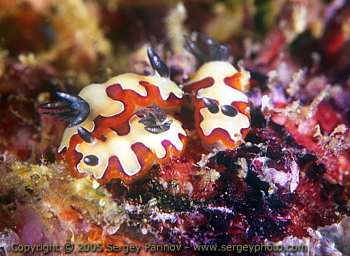
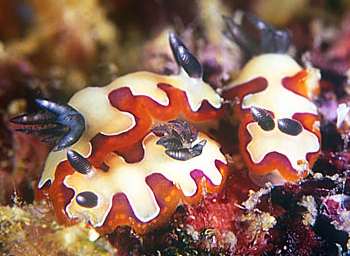
Dear Bill,
To accompany my other message [#14202], here is a photo of a group of Chromodoris fidelis from Mergui Archipelago, Burma.
Locality: South Mergui, Myanmar [Burma]. Indian Ocean, Andaman Sea.
Depth: 10 m. Length: 7-10 mm. February 2004. top of the underwater rocks
Photographer: Sergey Parinov
Sergey Parinov
www.sergeyphoto.com/underwater/
webmaster@sergeyphoto.com
Sergey Parinov, 2005 (Jul 6) Feeding Chromodoris fidelis from Burma. [Message in] Sea Slug Forum. Australian Museum, Sydney. Available from http://www.seaslugforum.net/find/14203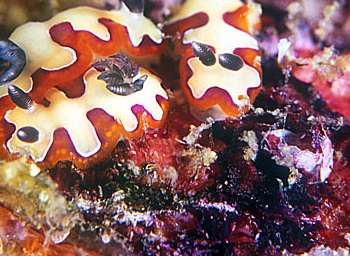
Dear Sergey,
Thanks for this photo. When I see a group of nudibranchs together like this my first thought is that their food must be nearby. The dark purplish object in the foreground is almost certainly their favourite food sponge Chelonaplysilla violacea. The animal on the right seems to have its buccal bulb extended out below the mantle skirt.
Best wishes,
Bill Rudman
Chromodoris fidelis from Nth Borneo
March 18, 2004
From: Glenn Robert
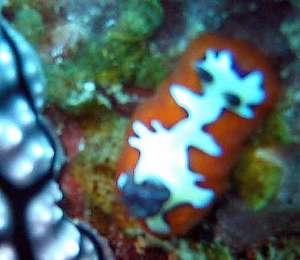
Hi,
Could you identify this slug which was next to Phyllidiella pustulosa. It is red and white in colour with black gills and tentacles. It was found in East Malaysia (Malaysia) aka North Borneo. I appreciate the help as I couldn't find in any of my books.
Location: Sapi Island off the coast of the State of Sabah, Malaysia. Depth: 9M. Temperature: 27C
Glenn Robert
ngelg@yahoo.co.uk
Robert, G., 2004 (Mar 18) Chromodoris fidelis from Nth Borneo. [Message in] Sea Slug Forum. Australian Museum, Sydney. Available from http://www.seaslugforum.net/find/12478Dear Glenn,
This is a colour form of Chromodoris fidelis
Best wishes
Bill Rudman
Chromodoris fidelis feeding [1]
February 16, 2004
From: Scott Johnson
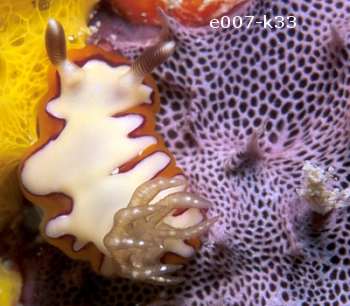
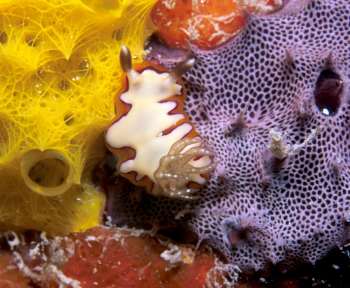
Hi Bill,
Chromodoris fidelis in the Marshall Islands feeds on several apparently different sponges. e007-k33 shows it on the purple sponge Chelonaplysilla violacea at Kwajalein, Marshall Islands (depth about 8 meters under a dead coral rock). While this specimen did not appear to be in the process of feeding when this photo was taken, I have definitely observed it eating this sponge.
I have a few more that I will send separately [see messages #12221, #12229, #12230, #12231, #12232].
Scott
johnson@kmr.ll.mit.edu
Johnson, R.F., 2004 (Feb 16) Chromodoris fidelis feeding [1]. [Message in] Sea Slug Forum. Australian Museum, Sydney. Available from http://www.seaslugforum.net/find/12220Thanks Scott,
For ease of later reference I have split your photos up. Certainly Chelonaplysilla violacea seems to be a recurring food of this species, but the others are new to me
Best wishes
Bill Rudman
Chromodoris fidelis feeding [4]
February 16, 2004
From: Scott Johnson
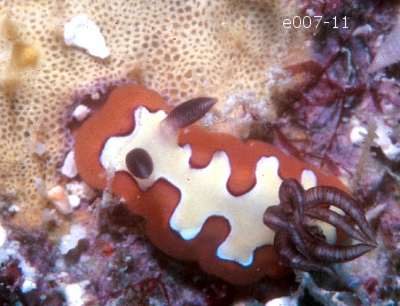
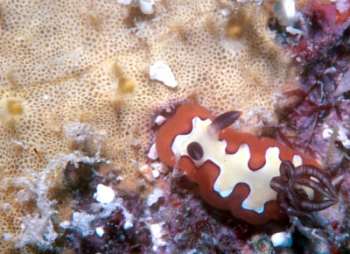
Hi Bill,
Here is another message about Chromodoris fidelis in the Marshall Islands and the apparently different sponges it feeds on [see message #12220]. I think this and the next two [messages #12231, #12232] are slight variations of the same sponge. These were all under dead coral rocks on the lagoon reef of Enewetak Island at a depth of 3-8m.
Scott
johnson@kmr.ll.mit.edu
Johnson, S., 2004 (Feb 16) Chromodoris fidelis feeding [4]. [Message in] Sea Slug Forum. Australian Museum, Sydney. Available from http://www.seaslugforum.net/find/12221Thanks Scott,
I would agree these three sponges look very similar. I'll check it out
Best wishes,
Bill Rudman
Chromodoris fidelis feeding [2]
February 16, 2004
From: Scott Johnson
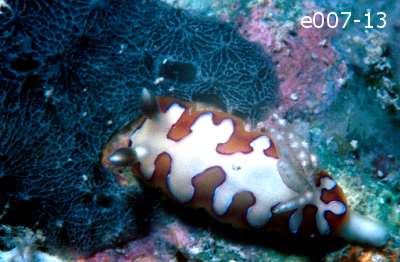
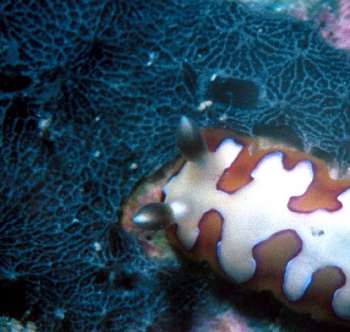
Hi Bill,
Here is another message about Chromodoris fidelis in the Marshall Islands and the apparently different sponges it feeds on [see message #12220].
E007-13 is a shot of an Enewetak Atoll specimen eating a dark gray sponge. I have a few more that I will send separately.
Scott
johnson@kmr.ll.mit.edu
Johnson, S., 2004 (Feb 16) Chromodoris fidelis feeding [2]. [Message in] Sea Slug Forum. Australian Museum, Sydney. Available from http://www.seaslugforum.net/find/12229Thanks Scott,
Bill Rudman
Chromodoris fidelis feeding [3]
February 16, 2004
From: Scott Johnson
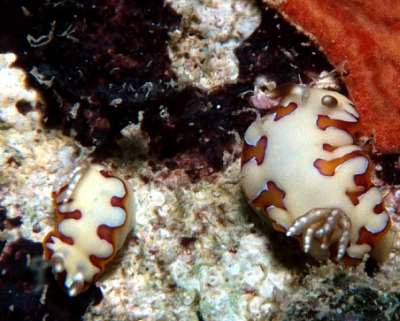
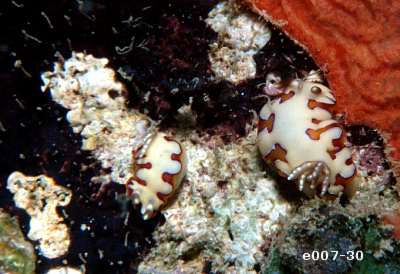
Hi Bill,
Here is another message about Chromodoris fidelis in the Marshall Islands and the apparently different sponges it feeds on [see message #12220].
E007-30, also from Enewetak, shows two specimens grazing away a very dark maroon --almost black -- sponge right down to the coral rock substrate.
I have a few more that I will send separately.
Scott
johnson@kmr.ll.mit.edu
Johnson, S., 2004 (Feb 16) Chromodoris fidelis feeding [3]. [Message in] Sea Slug Forum. Australian Museum, Sydney. Available from http://www.seaslugforum.net/find/12230Thanks Scott,
There is a 'shiny and purple-black' species of Chelonaplysilla described from a single specimen from Hawaii which could well be this species. It wil be interesting to have it checked out
Best wishes
Bill Rudman
Chromodoris fidelis feeding [5]
February 16, 2004
From: Scott Johnson
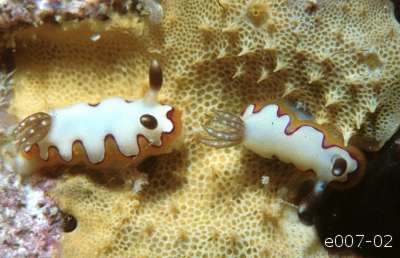
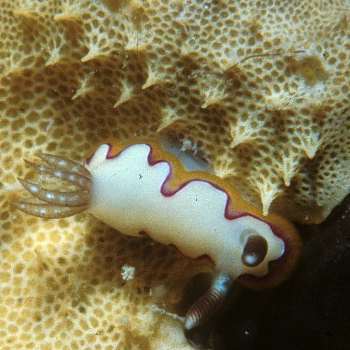
Hi Bill,
Here is another message about Chromodoris fidelis in the Marshall Islands and the apparently different sponges it feeds on [see message #12220]. This is one of three which I think [messages #12221, #12232] are slight variations of the same sponge. These were all under dead coral rocks on the lagoon reef of Enewetak Island at a depth of 3-8m.
Scott
johnson@kmr.ll.mit.edu
Johnson, S., 2004 (Feb 16) Chromodoris fidelis feeding [5]. [Message in] Sea Slug Forum. Australian Museum, Sydney. Available from http://www.seaslugforum.net/find/12231Thanks Scott,
Bill Rudman
Chromodoris fidelis feeding [6]
February 16, 2004
From: Scott Johnson
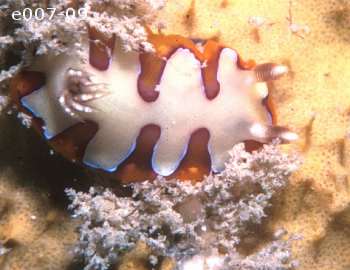
Hi Bill,
Here is another message about Chromodoris fidelis in the Marshall Islands and the apparently different sponges it feeds on [see message #12220]. This is one of three which I think [messages #12221, "#12231] are slight variations of the same sponge. These were all under dead coral rocks on the lagoon reef of Enewetak Island at a depth of 3-8m.
Scott
johnson@kmr.ll.mit.edu

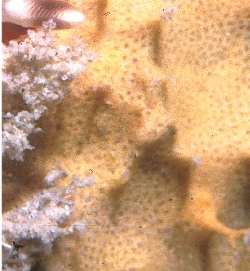
Thanks Scott,
Bill Rudman
Chromodoris fidelis from Thailand
February 14, 2004
From: Danny Van Belle
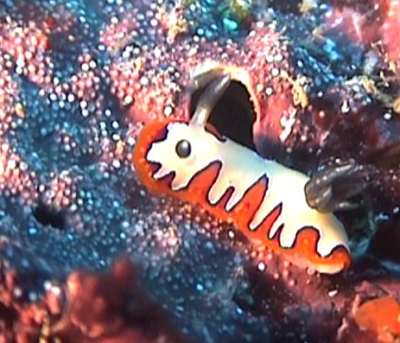
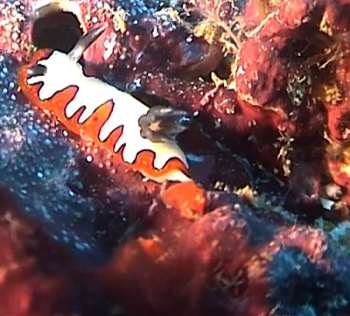
Dear Bill,
Some shots of Chromodoris fidelis!
Filmed at Phi Phi islands - Andaman sea - Thailand. Date 9 March 2002
Depth +- 10 meters.
Divesite Koh Bida
Danny Van Belle
danny.van.belle@skynet.be
van Belle, D., 2004 (Feb 14) Chromodoris fidelis from Thailand. [Message in] Sea Slug Forum. Australian Museum, Sydney. Available from http://www.seaslugforum.net/find/12210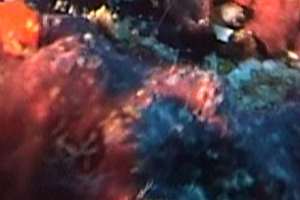
Thanks Danny,
Its possible the blue sponge may be its food. It might be a bit hard to identify from these photos, but it certainly worth keeping a record of, in case its found on this sponge again.
Best wishes
Bill Rudman
Chromodoris fidelis - feeding
April 10, 2003
From: Kheong San Chan
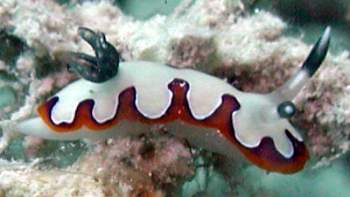
Dear Bill,
On the last dive at Layang Layang, also from the shore, March 30th, we came across a fish trap with some small nudis on it. They were most probably consuming this small purple sponge on the trap. We counted 4 animals, and later found one more in the photos, just visible on the underside of the wires making up the fish-trap.
One of these nudis started away from the sponge, at first I thought he wanted to come around to the other side of the sponge, but he just kept going. These animals are small, maybe 2-3cm, so I am not sure if that is their full grown size or they are juveniles. The trap was around 5m deep.
[Layang Layang, also known as Swallows Reef, is approx 300 km northwest of Kota Kinabalu, Sabah, Malaysia, in the South China Sea]
Kheong
kschan@mail.dsi.nus.edu.sg

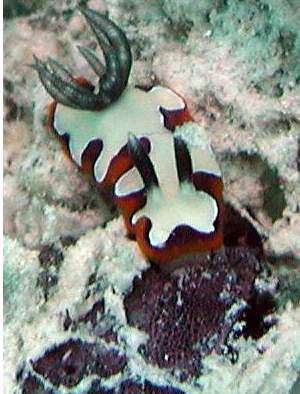
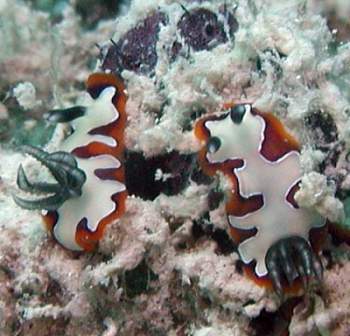
Dear Kheong,
Your mystery animal is one of the colour variants of Chromodoris fidelis. It is a relatively small chromdorid, so the animals you found were probably fully grown. It certainly seems very interested in the purple sponge, which is nice confirmation for Marli Wakeling's earlier photo of another colour variant eating this purple sponge. As I say there, the sponge looks very similar to Chelonaplysilla violacea, which is the purple sponge that the red-spotted Chromodoris cf. fidelis feeds on in northern new South Wales.
Chromodoris fidelis from Sulawesi
May 8, 2002
From: Mary Jane Adams
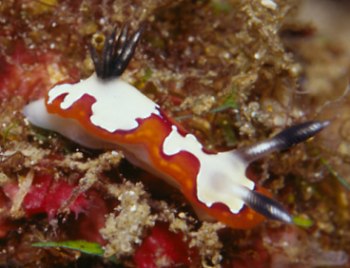
Hi Bill,
I found this Chromodoris fidelis crawling over a coral reef at 18 meters. It is 10 mm long. Is it a juvenile? How big do they get?
Divesite: Nudi Retreat, Lembeh Strait, Sulawesi, Indonesia, April 19, 2002
Best regards,
Mary Jane
divepng@yahoo.com
Adams, M J., 2002 (May 8) Chromodoris fidelis from Sulawesi. [Message in] Sea Slug Forum. Australian Museum, Sydney. Available from http://www.seaslugforum.net/find/6870Dear Mary Jane,
This species doesn't grow as large as some. Anything longer than about 25mm would be a very big specimen.
Best wishes,
Bill Rudman
Chromodoris fidelis from Indonesia
March 28, 2002
From: Alice Lee
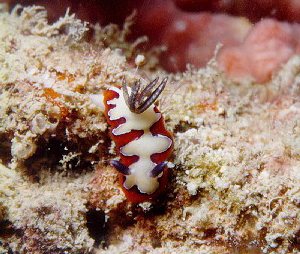
Hi, Bill,
Here is a photo of Chromodoris fidelis. It was taken in Riau Archipelago, [Indonesia, just south of Singapore] size about 10mm at the depth of 10m.
Alice Lee
alee@dlink.com.sg
Lee, A., 2002 (Mar 28) Chromodoris fidelis from Indonesia. [Message in] Sea Slug Forum. Australian Museum, Sydney. Available from http://www.seaslugforum.net/find/6557Thanks Alice,
Bill Rudman
Chromodoris fidelis from Bali
March 11, 2002
From: Stuart Hutchison
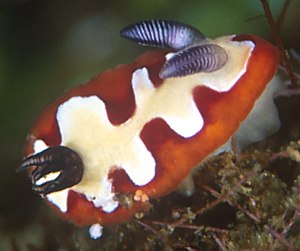
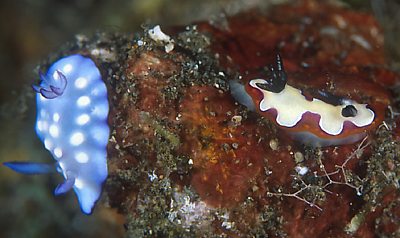
Bill,
Here are two Chromodoris fidelis from Bali, Indonesia on 21 Oct 2001. Depth 10m, lengths around 15mm.
Regards,
Stuart
stuart@stuarthutchison.com.au
Hutchison, S., 2002 (Mar 11) Chromodoris fidelis from Bali. [Message in] Sea Slug Forum. Australian Museum, Sydney. Available from http://www.seaslugforum.net/find/6287Thanks Stuart,
I guess the white-spotted chromodorid on the left of the lower photo is a juvenile Chromodoris hintuanensis which you report finding at the same time in an earlier message. This is an interesting colour form of C. fidelis in which the orange and reddish border merge into a single red band.
Cheers,
Bill Rudman
Chromodoris fidelis from Hong Kong
January 28, 2002
From: Bill Rudman & Brian Darvell
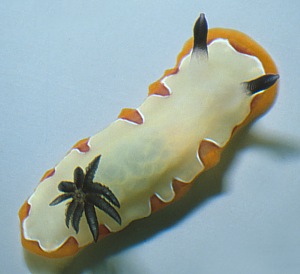
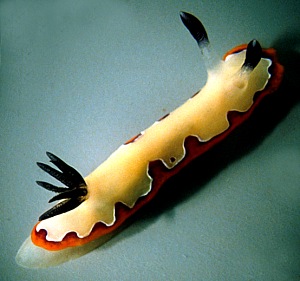
Here is some information and photos on Chromodoris fidelis from Brian Darvell's Hong Kong collections.
One of a group of white species with orange mantle border. Characterized by black gills and rhinophores and red or purple patches on mantle on the inside edge of the orange border. Anatomy and taxonomy reviewed recently (Rudman 1985). Grows to 26 mm in length. It is reported by Johnson and Boucher (1983) to feed on the purple sponge Aplysilla violacea Lendenfield, 1883, in the Marshall Islands.
PHOTO:
Upper: AM C142951, 2 specimens, 22 July 1984, Site 2.67, Kai Kung Tau, Kat 0 Chan, Mirs Bay, [depth not known], Hong Kong.
Lower: AM C134758, 2 specimens, 25 July 1982, Site 1.4, Ngo Mei Wan, Crescent Is., Mirs Bay, 9 m, Hong Kong. Photos: Brian Darvell.
Hong Kong Collection Records:
AM C134758, 2 specimens, 25 July 1982, Site 1.4, Ngo Mei Wan, Crescent Is., Mirs Bay, 9 m. AM C137063, 10 October 1982, Site 1.34, Tsing Chau, Crooked Harbour, 6 m. AM C142951, 2 specimens, 22 July 1984, Site 2.67, Kai Kung Tau, Kat 0 Chan, Mirs Bay, [depth not known]. AM C142952, 2 specimens, 29 July 1984, Site II. 1 17, Duck Rocks (N), Port Shelter, 9 m. Depth range: 6-9 m.
Reference:
• Rudman, W.B. & Darvell, B.W. (1990) Opisthobranch molluscs of Hong Kong. Part 1. Goniodorididae, Onchidorididae, Triophidae, Gymnodorididae, Chromodorididae, (Nudibranchia). Asian Marine Biology, 7: 31-79
Best wishes,
Bill Rudman & Brian Darvell
Re: Chromodoris fidelis from Tufi, Papua New Guinea
October 15, 2001
From: Des Paroz
Hi Bill
It was a small animal - only about 10-15mm. It was shot at pretty close to 1:1.
Best regards
Des
des@paroz.com
Paroz, D., 2001 (Oct 15) Re: Chromodoris fidelis from Tufi, Papua New Guinea. [Message in] Sea Slug Forum. Australian Museum, Sydney. Available from http://www.seaslugforum.net/find/5469Chromodoris fidelis from Tufi, Papua New Guinea
October 14, 2001
From: Des Paroz

Hi Bill
Yet another nudi found in "The Muck" area around Tufi Wharf, Papua New Guinea. This one appears to be Chromodoris fidelis.
Water temp 28C, depth 11m, little water movement, September 2001.
Best regards
Des
des@paroz.com
Paroz, D., 2001 (Oct 14) Chromodoris fidelis from Tufi, Papua New Guinea. [Message in] Sea Slug Forum. Australian Museum, Sydney. Available from http://www.seaslugforum.net/find/5455Thanks Des,
Interestingly, most of the photos in the Forum are from Papua New Guinea. from the proportionally large size of the rhinophores I would suspect this was quite a small animal. Can you give me some idea of size please?
Thanks,
Bill Rudman
Chromodoris fidelis from Papua New Guinea
October 4, 2001
From: Marli Wakeling
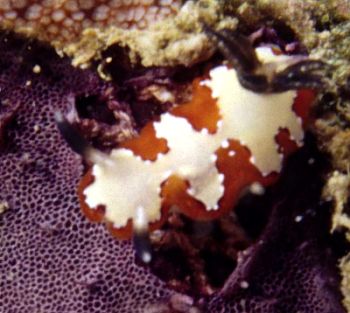
Dear Bill,
I believe that this little beauty is a Chromodoris fidelis, found in Kavieng Harbour, Papua New Guinea, August, 2001.
Dive Site: The Old Slipway, Kavieng, Papua New Guinea
Depth: 3 meters
Length: 7 mm
PHOTO: Marli Wakeling
Cheers,
Marli
scubamarli@excite.com
Wakeling, M., 2001 (Oct 4) Chromodoris fidelis from Papua New Guinea. [Message in] Sea Slug Forum. Australian Museum, Sydney. Available from http://www.seaslugforum.net/find/5362Dear Marli,
Yes this is one of the colour forms of C. fidelis. Of particular interest is the sponge you have found this animal on. It seems to be Chelonaplysilla violacea which is an aplysillid sponge which incorporates sand grains into its skeleton. I have found the spotted New South Wales colour form of C. fidelis on the same, or very similar sponge.
Best wishes,
Bill Rudman.
Another variant of Chromodoris fidelis
August 16, 2000
From: Stuart Hutchison
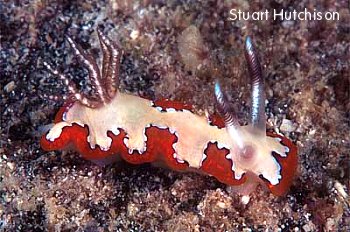
Dear Bill,
Here is another shot of Chromodoris fidelis.. It is a slight variant on the earlier one I sent. From the 'Lady Jewel' (Lion Island - near Lolata Island, Papua New Guinea) in March 1999. Depth 10m, size 25mm.
Regards,
Stuart
hutchco@tpg.com.au
Hutchison, S., 2000 (Aug 16) Another variant of Chromodoris fidelis. [Message in] Sea Slug Forum. Australian Museum, Sydney. Available from http://www.seaslugforum.net/find/2880Thanks Stuart,
Bill Rudman.
Chromodoris fidelis from Papua New Guinea
August 13, 2000
From: Stuart Hutchison
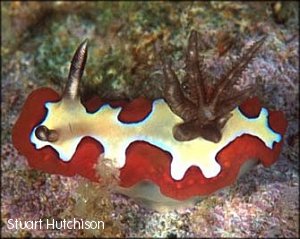
Dear Bill,
This Chromodoris fidelis was found on the 'Tuart', a sunken tug boat near Lion Island, Papua New Guinea (next to Loloata in Bootless Bay) at about 12m deep.
Stuart Hutchison.
hutchco@tpg.com.au
Hutchison, S., 2000 (Aug 13) Chromodoris fidelis from Papua New Guinea. [Message in] Sea Slug Forum. Australian Museum, Sydney. Available from http://www.seaslugforum.net/find/2867Dear Stuart,
Bergh (1905) named this rather distinctive colour form C. flammulata, but at present I can find no anatomical differences from C. fidelis.
Thanks for this great photo.
Bill Rudman.
Chromodoris fidelis from South Africa
April 2, 2000
From: Valda Fraser
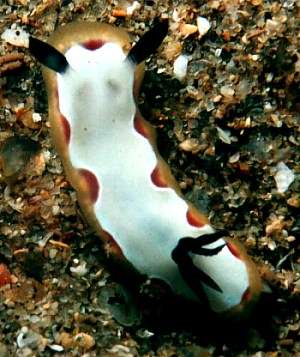
Dear Bill
Please help by identifying this nudibranch for me. I am beginning to feel very guilty for all my pestering!
Locality: South Coast KwaZulu-Natal SOUTH AFRICA. Park Rynie - 34m
Date: March 2000
Size: 12mm
Regards
Valda Fraser
iti04937@mweb.co.za
Fraser, V., 2000 (Apr 2) Chromodoris fidelis from South Africa. [Message in] Sea Slug Forum. Australian Museum, Sydney. Available from http://www.seaslugforum.net/find/2184Dear Valda,
This is one of the colour forms of Chromodoris fidelis. It looks very like the one from the Red Sea at the top of the page.
Don't worry about sending messages. That's the purpose of the Forum. Every message you send is a bit of information shared. Your photos ahve probably doubled our knowledge of the South African opisthobranch fauna.
This photo is a good example. Chromodoris fidelis is quite variable in colour. By recording the colour varieties and where they occur, we can hopefully see if there is any geographic pattern to the variation, such as the unique colour form found in eastern Australia.
So keep the questions and photos coming. I can't always answer them immediately, but I will do my best.
Best wishes,
Bill Rudman.
